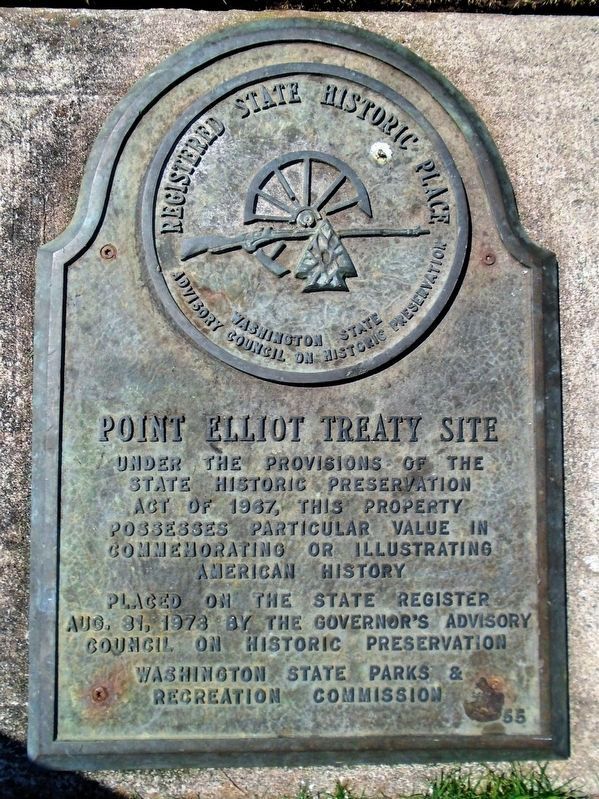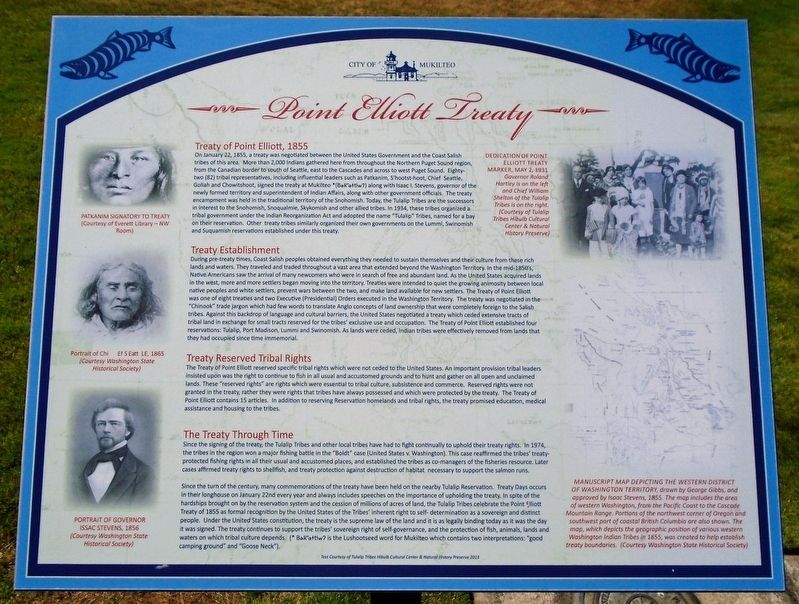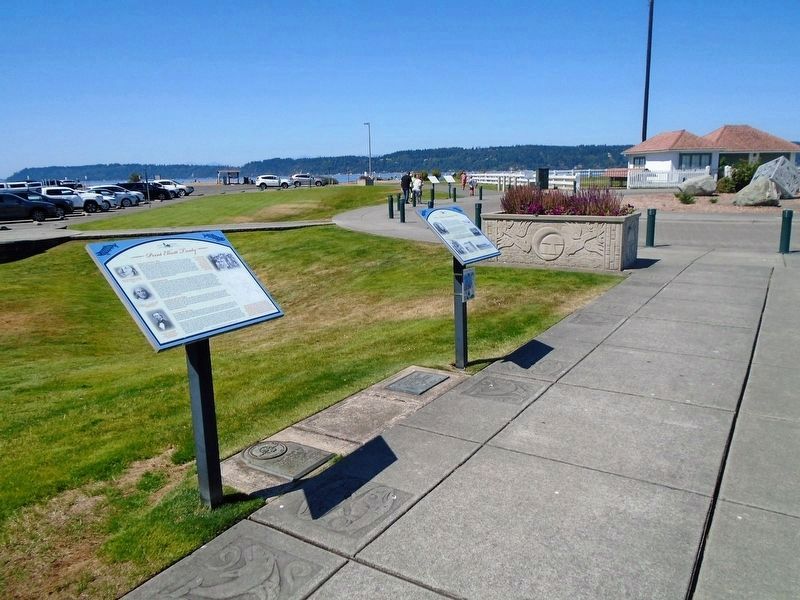Mukilteo in Snohomish County, Washington — The American West (Northwest)
Point Elliott Treaty
Mulkilteo Walking Tour Stop 2
— Registered State Historic Place —
Treaty of Point Elliott, 1855
On January 22, 1855, a treaty was negotiated between the United States Government and the Coast Salish tribes of this area. More than 2,000 Indians gathered here from throughout the Northern Puget Sound region, from the Canadian border to south of Seattle east to the Cascades and across to west Puget Sound. Eighty-two (82) tribal representatives, including influential leaders such as Patkanim, S'hootst-hoot, Chief Seattle, Goliah and Chowitshoot, signed the treaty at Mukilteo *(Bək'wəttiwʔ) along with Isaac I. Stevens, governor of the newly formed territory and superintendent of Indian Affairs, along with other government officials. The treaty encampment was held in the traditional territory of the Snohomish. Today, the Tulalip Tribes are the successors in interest to the Snohomish, Skykomish and other allied tribes. In 1934, these tribes organized a tribal government under the Indian Reorganization Act and adopted the name "Tulalip" Tribes, named for a bay on their reservation. Other treaty tribes similarly organized their own governments on the Lummi, Swinomish and Suquamish reservations established under this treaty.
Treaty Establishment
During pre-treaty times, Coast Salish peoples obtained everything they needed to sustain themselves and their culture from these rich lands and waters. They traveled and traded throughout a vast area that extended beyond the Washington Territory. In the mid-1850's, Native Americans saw the arrival of many newcomers who were in search of free and abundant land. As the United States acquired lands in the west, more and more settlers began moving into the territory. Treaties were intended to quiet the growing animosity between local native peoples and white settlers, prevent wars between the two, and make land available for new settlers. The Treaty of Point Elliott was one of eight treaties and two Executive (Presidential) Orders executed in the Washington Territory. The treaty was negotiated in the "Chinook" trade jargon which had few words to translate Anglo concepts of land ownership that were completely foreign to the Salish tribes. Against this backdrop of language and cultural barriers, the United States negotiated a treaty that ceded extensive tracts of tribal land in exchange for small tracts reserved for the tribes' exclusive use and occupation. The Treaty of Point Elliott established four reservations: Tulalip, Port Madison, Lummi and Swinomish. As lands were ceded, Indian tribes were effectively removed from lands they had occupied since time immemorial.
Treaty Reserved Tribal Rights
The Treaty of Elliott Point reserved specific tribal

Photographed By William Fischer, Jr., July 29, 2021
2. Point Elliot Treaty Site Marker
The Treaty Through Time
Since the signing of the treaty, the Tulalip Tribes and other local tribes have had to fight continually to uphold their treaty rights. In 1974, the tribes in the region won a major fishing battle in the "Boldt" case (United States v. Washington). This case reaffirmed the tribes' treaty-protected fishing rights in all their usual and accustomed places, and established the tribes as co-managers of the fisheries resource. Later cases affirmed treaty rights to shellfish, and treaty protection against destruction of habitat necessary to support the salmon runs.
Since the turn of the century, many commemorations of the treaty have been held on the nearby Tulalip Reservation.
Treaty Days occurs in their longhouse on January 22nd every year and always includes speeches on the importance of upholding the treaty. In spite of the hardships brought on by the reservation system and the cession of millions of acres of land, the Tulalip Tribes celebrate the Point Elliott Treaty of 1855 as formal recognition by the United States of the Tribes' inherent right to self-determination as a sovereign and distinct people. Under the United States constitution, the treaty is the supreme law of the land and it is as legally binding today as it was the day it was signed. The treaty continues to support the tribes' sovereign right of self-governance, and the protection of fish, animals, lands and waters on which tribal culture depends. (* Bək'wəttiwʔ is the Lushootseed word for Mukilteo which contains two interpretations: "good camping ground" and "Goose Neck").
[Photo captions, clockwise from center left:]
• Portrait of Chief S Eatt LE, 1865
• PATKANIM - SIGNATORY TO TREATY
• DEDICATION OF POINT ELLIOTT TREATY MARKER, May 2, 1931 Governor Roland Hartley is on the left and Chief William Shelton of the Tulalip Tribes is on the right.
• MANUSCRIPT MAP DEPICTING THE WESTERN DISTRICT OF WASHINGTON TERRITORY, drawn by Isaac Stevens, 1855. The map includes the area of western Washington, from the Pacific Coast to the Cascade Mountain Range. Portions of the northwest corner of Oregon and southwest part of coastal British Columbia are also shown. The map, which depicts the geographic position of various western Washington Indian Tribes in 1855, was created to help establish treaty boundaries.
• PORTRAIT OF GOVERNOR ISSAC [sic] STEVENS, 1856
Under the provisions of the State Historic Preservation Act of 1967, this property possesses particular value in commemorating or illustrating American history.
Placed on the State Register Aug. 31, 1973 by the Governor's Advisory Council on Historic Preservation
Erected 1973 by City of Mukilteo and Washington State Parks & Recreation Commission. (Marker Number 55.)
Topics. This historical marker is listed in these topic lists: Native Americans • Peace • Settlements & Settlers • Wars, US Indian. A significant historical date for this entry is January 22, 1855.
Location. 47° 56.896′ N, 122° 18.34′ W. Marker is in Mukilteo, Washington, in Snohomish County. Marker is on Front Street, on the left when traveling west toward the traffic circle. Marker is at Mukilteo Lighthouse Park, southeast of the lighthouse. Touch for map. Marker is at or near this postal address: 609 Front Street, Mukilteo WA 98275, United States of America. Touch for directions.
Other nearby markers. At least 8 other markers are within walking distance of this marker. Commemorating Signing Point Elliott Treaty (here, next to this marker); Native Americans (here, next to this marker); Tradition of Carving (a few steps from this marker); Light Station and Park (a few steps from this marker); Early Explorers (within shouting distance of this marker); Geology of Mukilteo (within shouting distance of this marker); The Keeper's House (within shouting distance of this marker); Mukilteo Light Station (within shouting distance of this marker). Touch for a list and map of all markers in Mukilteo.
Also see . . .
1. Treaty of Point Elliott, 1855. (Submitted on August 5, 2021, by William Fischer, Jr. of Scranton, Pennsylvania.)
2. Treaty of Point Elliott - Duwamish Tribe View. (Submitted on August 5, 2021, by William Fischer, Jr. of Scranton, Pennsylvania.)
3. Chief Si'ahl - Duwamish Tribe. (Submitted on August 5, 2021, by William Fischer, Jr. of Scranton, Pennsylvania.)
Credits. This page was last revised on January 22, 2023. It was originally submitted on August 4, 2021, by William Fischer, Jr. of Scranton, Pennsylvania. This page has been viewed 1,153 times since then and 150 times this year. Photos: 1. submitted on August 5, 2021, by William Fischer, Jr. of Scranton, Pennsylvania. 2. submitted on August 4, 2021, by William Fischer, Jr. of Scranton, Pennsylvania. 3. submitted on August 5, 2021, by William Fischer, Jr. of Scranton, Pennsylvania.

